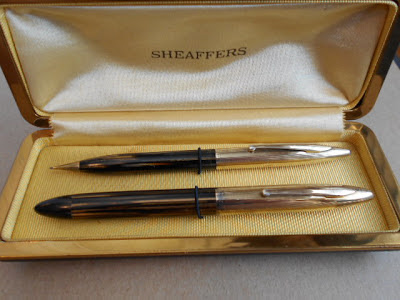This Scripto package appears to be the oldest, and there is no mention of the size of the lead at all. Inside it is 1.1 mm. This was before 0.9 mm was even invented, far less anything thinner. "Smooth Writing," though. And available in 10 degrees of black plus 17 colors!
And this metal slide-open yellow and blue box holds "Thin Leads" made by Sheaffer for their "Fineline" pencils. This thin lead is 0.9 mm. Come to find out this size is now called thick lead! 0.3 and 0.5 are now the thinnest leads.
This is a later box of Sheaffer leads is the same size, 0.9 mm. It has a clear plastic tray and a sliding metal top.
An all-plastic container of leads made by Scripto contains 4 inch long lead in the .046 inch size, which is approximately 1.1 mm. It says that the cap represents the color of the lead in this style of packaging. (See the colors they offered just below the Autopoint lead.)
The Autopoint Company obligingly still provides thick lead, 1.1 mm, in black, red, green and blue. The blue, green, and red are soft, while the black is medium (HB). It comes in these spiffy silver cardboard tubes.
Scripto made lots of colors. One box of "Thick Lead" (and this time it is .120 inch, or 3 mm) says this thickness was. . .
I received this wooden container of lead in the mail today, it looks brand new and has never been opened. It was made by A.W. Faber of Newark, New Jersey. It is soft (B), and until I open it, I will have to take the word of the seller that it is 1.1 mm. It's so perfect, I kinda hate to open it!
Pentel makes a nice selection of leads for their currently available models. I was able to buy three grades of 0.9 mm lead to go in my post-1938 mechanical pencils: HB, B, and 2B. That's medium, soft, and soft times 2. I found this right next to some serious-looking black Pentels and some neon-colored, glitter-plastic Pentels. They can't hold a candle to the vintage pencils, but I do like the Pentel Clic Eraser. Someone was watching pencil erasers being extruded from the machine one day and thought, Why cut them up? Why not just sell one looooooong eraser? Great idea, Someone!
Before my conversion to vintage pencils, I found this polymer lead from two long-time pencil makers in Germany to be nice for my really thin lead pencils.
One thing that was included on the old packages that you don't find today is this, on the back of the earliest Scripto lead box: How to put the lead in the pencil!


















































